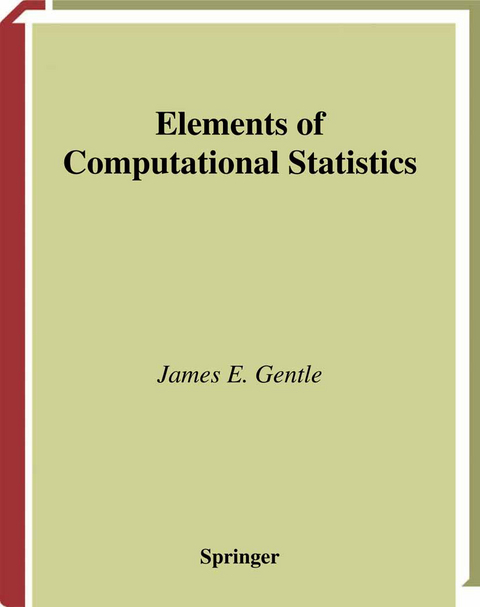
Elements of Computational Statistics
Seiten
2002
Springer-Verlag New York Inc.
978-0-387-95489-9 (ISBN)
Springer-Verlag New York Inc.
978-0-387-95489-9 (ISBN)
Describes techniques used in computational statistics and considers some of the areas of application, such as density estimation and model building. This book explains numerical techniques for transformations, for function approximation, and for optimization. It is suitable for various courses in modern statistics.
In recent years developments in statistics have to a great extent gone hand in hand with developments in computing. Indeed, many of the recent advances in statistics have been dependent on advances in computer science and techn- ogy. Many of the currently interesting statistical methods are computationally intensive, eitherbecausetheyrequireverylargenumbersofnumericalcompu- tions or because they depend on visualization of many projections of the data. The class of statistical methods characterized by computational intensity and the supporting theory for such methods constitute a discipline called “com- tational statistics”. (Here, I am following Wegman, 1988, and distinguishing “computationalstatistics”from“statisticalcomputing”, whichwetaketomean “computational methods, including numerical analysis, for statisticians”.) The computationally-intensive methods of modern statistics rely heavily on the developments in statistical computing and numerical analysis generally. Computational statistics shares two hallmarks with other “computational” sciences, such as computational physics, computational biology, and so on. One is a characteristic of the methodology: it is computationally intensive. The other is the nature of the tools of discovery. Tools of the scienti?c method have generally been logical deduction (theory) and observation (experimentation). The computer, used to explore large numbers of scenarios, constitutes a new type of tool. Use of the computer to simulate alternatives and to present the research worker with information about these alternatives is a characteristic of thecomputationalsciences. Insomewaysthisusageisakintoexperimentation. The observations, however, are generated from an assumed model, and those simulated data are used toevaluate and study the model.
In recent years developments in statistics have to a great extent gone hand in hand with developments in computing. Indeed, many of the recent advances in statistics have been dependent on advances in computer science and techn- ogy. Many of the currently interesting statistical methods are computationally intensive, eitherbecausetheyrequireverylargenumbersofnumericalcompu- tions or because they depend on visualization of many projections of the data. The class of statistical methods characterized by computational intensity and the supporting theory for such methods constitute a discipline called “com- tational statistics”. (Here, I am following Wegman, 1988, and distinguishing “computationalstatistics”from“statisticalcomputing”, whichwetaketomean “computational methods, including numerical analysis, for statisticians”.) The computationally-intensive methods of modern statistics rely heavily on the developments in statistical computing and numerical analysis generally. Computational statistics shares two hallmarks with other “computational” sciences, such as computational physics, computational biology, and so on. One is a characteristic of the methodology: it is computationally intensive. The other is the nature of the tools of discovery. Tools of the scienti?c method have generally been logical deduction (theory) and observation (experimentation). The computer, used to explore large numbers of scenarios, constitutes a new type of tool. Use of the computer to simulate alternatives and to present the research worker with information about these alternatives is a characteristic of thecomputationalsciences. Insomewaysthisusageisakintoexperimentation. The observations, however, are generated from an assumed model, and those simulated data are used toevaluate and study the model.
Methods of Computational Statistics.- Preliminaries.- Monte Carlo Methods for Inference.- Randomization and Data Partitioning.- Bootstrap Methods.- Tools for Identification of Structure in Data.- Estimation of Functions.- Graphical Methods in Computational Statistics.- Data Density and Structure.- Estimation of Probability Density Functions Using Parametric Models.- Nonparametric Estimation of Probability Density Functions.- Structure in Data.- Statistical Models of Dependencies.
| Erscheint lt. Verlag | 28.6.2005 |
|---|---|
| Reihe/Serie | Statistics and Computing |
| Zusatzinfo | XVIII, 420 p. |
| Verlagsort | New York, NY |
| Sprache | englisch |
| Maße | 155 x 235 mm |
| Themenwelt | Mathematik / Informatik ► Informatik ► Theorie / Studium |
| Mathematik / Informatik ► Mathematik ► Computerprogramme / Computeralgebra | |
| Mathematik / Informatik ► Mathematik ► Statistik | |
| Mathematik / Informatik ► Mathematik ► Wahrscheinlichkeit / Kombinatorik | |
| ISBN-10 | 0-387-95489-9 / 0387954899 |
| ISBN-13 | 978-0-387-95489-9 / 9780387954899 |
| Zustand | Neuware |
| Haben Sie eine Frage zum Produkt? |
Mehr entdecken
aus dem Bereich
aus dem Bereich
Grundlagen – Anwendungen – Perspektiven
Buch | Softcover (2022)
Springer Vieweg (Verlag)
34,99 €
was jeder über Informatik wissen sollte
Buch | Softcover (2024)
Springer Vieweg (Verlag)
37,99 €
Eine Einführung in die Systemtheorie
Buch | Softcover (2022)
UTB (Verlag)
25,00 €


